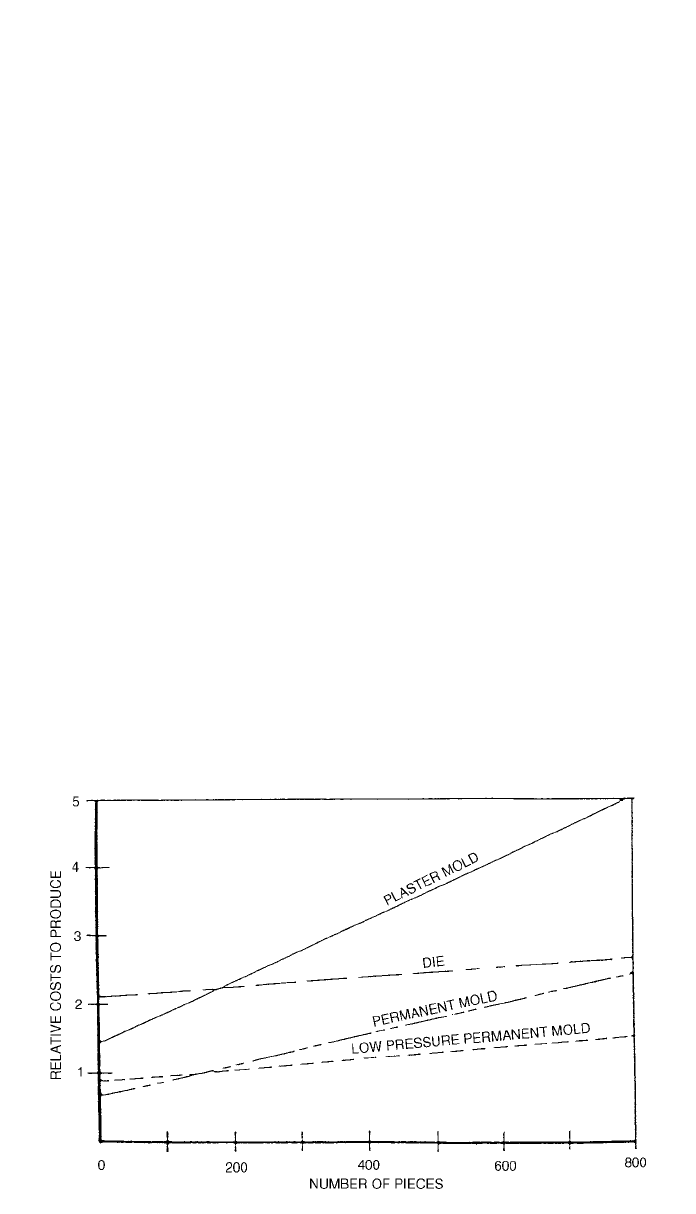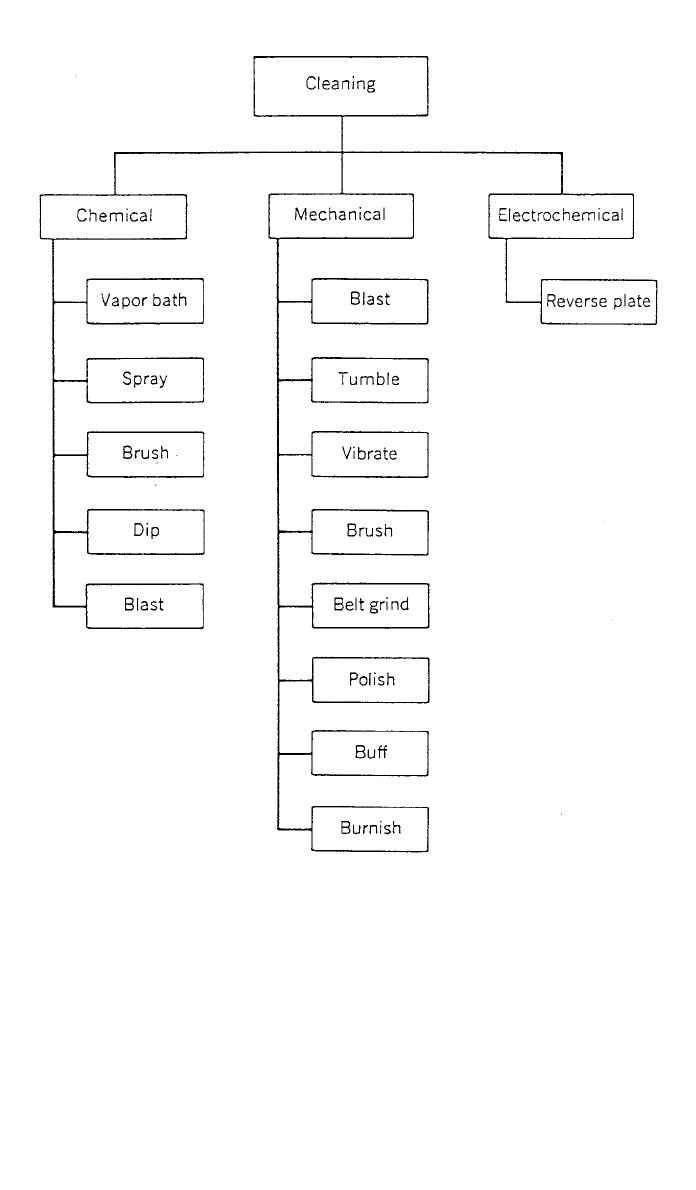Kutz M. Handbook of materials selection
Подождите немного. Документ загружается.


954 METAL FORMING, SHAPING, AND CASTING
Fig. 21 Cost comparison of various casting systems.
Metal Molds and Cores
In permanent-mold casting, both metal molds and cores are used, the metal being
poured into the mold cavity with the usual gravity head as in sand casting. Molds
are normally made of dense iron or meehanite, large cores of cast iron, and
small or collapsible cores of alloy steel. All necessary sprues, runners, gates,
and risers must be machined into the mold, and the mold cavity itself is made
with the usual metal-shrinkage allowances. The mold is usually composed of
one, two, or more parts, which may swing or slide for rapid operation. Whereas
in sand casting the longest dimension is always placed in a horizontal position,
in permanent-mold casting the longest dimension of a part is normally placed
in a vertical position.
Production Quantities
Wherever quantities are in the range of 500 pieces or more, permanent-mold
casting becomes competitive in cost with sand casting, and if the design is
simple, runs as small as 200 pieces are often economical. Production runs of
1000 pieces or more will generally produce a favorable cost difference. High
rates of production are possible, and multiple-cavity dies with as many as 16
cavities can be used. In casting gray iron in multiple molds, as many as 50,000
castings per cavity are common with small parts. With larger parts of gray iron,
weighing from 12 to 15 lb, single-cavity molds normally yield 2000–3000 pieces
per mold on an average. Up to 100,000 parts per cavity or more are not uncom-
mon with nonferrous metals, magnesium providing the longest die life. Low-
pressure permanent-mold casting is economical for quantities up to 40,000
pieces (Fig. 21).
Die Casting
Die casting may be classified as a permanent-mold casting system; however, it
differs from the process just described in that the molten metal is forced into

4 METAL CASTING AND MOLDING PROCESSES 955
the mold or die under high pressure [1000–30,000 psi (6.89–206.8 MPa)]. The
metal solidifies rapidly (within a fraction of a second) because the die is water-
cooled. Upon solidification, the die is opened and ejector pins automatically
knock the casting out of the die. If the parts are small, several of them may be
made at one time in what is termed a multicavity die.
There are two main types of machines used: the hot-chamber and the cold-
chamber types.
Hot-Chamber Die Casting. In the hot-chamber machine, the metal is kept
in a heated holding pot. As the plunger descends, the required amount of alloy
is automatically forced into the die. As the piston retracts, the cylinder is again
filled with the right amount of molten metal. Metals such as aluminum, mag-
nesium, and copper tend to alloy with the steel plunger and cannot be used in
the hot chamber.
Cold-Chamber Die Casting. This process gets its name from the fact that
the metal is ladled into the cold chamber for each shot. This procedure is nec-
essary to keep the molten-metal contact time with the steel cylinder to a mini-
mum. Iron pickup is prevented, as is freezing of the plunger in the cylinder.
Advantages and Limitations
Die-casting machines can produce large quantities of parts with close tolerances
and smooth surfaces. The size is limited only by the capacity of the machine.
Most die castings are limited to about 75 lb (34 kg) of zinc; 65 lb (30 kg) of
aluminum; and 44 lb (20 kg) of magnesium. Die castings can provide thinner
sections than any other casting process. Wall thickness as thin as 0.015 in. (0.38
mm) can be achieved with aluminum in small items. However, a more common
range on larger sizes will be 0.105–0.180 in. (2.67–4.57 mm).
Some difficulty is experienced in getting sound castings in the larger capac-
ities. Gases tend to be entrapped, which results in low strength and annoying
leaks. Of course, one way to reduce metal sections without sacrificing strength
is to design in ribs and bosses. Another approach to the porosity problem has
been to operate the machine under vacuum. This process is now being developed.
The surface quality is dependent on that of the mold. Parts made from new
or repolished dies may have a surface roughness of 24
in. (0.61
m). The high
surface finish available means that, in most cases, coatings such as chromeplat-
ing, anodizing, and painting may be applied directly. More recently, decorative
finishes of texture, as obtained by photoetching, have been applied. The tech-
nique has been used to simulate woodgrain finishes, as well as textile and leather
finishes, and to obtain checkering and crosshatching.
4.4 Plaster-Mold Casting
In general, the various methods of plaster-mold casting are similar. The plaster,
also known as gypsum or calcium sulfate, is mixed dry with other elements,
such as talc, sand, asbestos, and sodium silicate. To this mix is added a controlled
amount of water to provide the desired permeability in the mold. The slurry that
results is heated and delivered through a hose to the flasks, all surfaces of which
have been sprayed with a parting compound. The plaster slurry readily fills in
and around the most minute details in the highly polished brass patterns. Fol-

956 METAL FORMING, SHAPING, AND CASTING
lowing filling, the molds are subjected to a short period of vibration and the
slurry sets in 5–10 min.
Molds
Molds are extracted from the flask with a vacuum head, following which drying
is completed in a continuous oven. Copes and drags are then assembled, with
cores when required, and the castings are poured. Upon solidification, the plaster
is broken away and any cores used are washed out with a high-pressure jet of
water.
4.5 Investment Casting
Casting processes in which the pattern is used only once are variously referred
to as lost-wax or precision-casting processes. They involve making a pattern of
the desired form out of wax or plastic (usually polystyrene). The expendable
pattern may be made by pressing the wax into a split mold or by the use of an
injection-molding machine. The patterns may be gated together so that several
parts can be made at once. A metal flask is placed around the assembled patterns
and a refractory mold slurry is poured in to support the patterns and form the
cavities. A vibrating table equipped with a vacuum pump is used to eliminate
all the air from the mold. Formerly, the standard procedure was to dip the pat-
terns in the slurry several times until a coat was built up. This is called the
investment process. After the mold material has set and dried, the pattern ma-
terial is melted and allowed to run out of the mold.
The completed flasks are heated slowly to dry the mold and to melt out the
wax, plastic, or whatever pattern material was used. When the molds have
reached a temperature of 100
⬚F (37.8⬚C), they are ready for pouring. Vacuum
may be applied to the flasks to ensure complete filling of the mold cavities.
When the metal has cooled, the investment material is removed by vibrating
hammers or by tumbling. As with other castings, the gates and risers are cut off
and ground down.
Ceramic Process
The ceramic process is somewhat similar to the investment casting in that a
creamy ceramic slurry is poured over a pattern. In this case, however, the pattern,
made out of plastic, plaster, wood, metal, or rubber, is reusable. The slurry
hardens on the pattern almost immediately and becomes a strong green ceramic
of the consistency of vulcanized rubber. It is lifted off the pattern while it is still
in the rubberlike phase. The mold is ignited with a torch to burn off the volatile
portion of the mix. It is then put in a furnace and baked at 1800
⬚F (982⬚C),
resulting in a rigid refractory mold. The mold can be poured while still hot.
Full-Mold Casting
Full-mold casting may be considered a cross between conventional sand casting
and the investment technique of using lost wax. In this case, instead of a con-
ventional pattern of wood, metals, or plaster, a polystyrene foam or styrofoam
is used. The pattern is left in the mold and is vaporized by the molten metal as
it rises in the mold during pouring. Before molding, the pattern is usually coated
with a zirconite wash in an alcohol vehicle. The wash produces a relatively

5 PLASTIC-MOLDING PROCESSES 957
tough skin separating the metal from the sand during pouring and cooling. Con-
ventional foundry sand is used in backing up the mold.
5 PLASTIC-MOLDING PROCESSES
Plastic molding is similar in many ways to metal molding. For most molding
operations, plastics are heated to a liquid or a semifluid state and are formed in
a mold under pressure. Some of the most common molding processes are dis-
cussed below.
5.1 Injection Molding
The largest quantity of plastic parts is made by injection molding. Plastic com-
pound is fed in powdered or granular form from a hopper through metering and
melting stages and then injected into a mold. After a brief cooling period, the
mold is opened and the solidified part is ejected.
5.2 Coinjection Molding
Coinjection molding makes it possible to mold articles with a solid skin of one
thermoplastic and a core of another thermoplastic. The skin material is usually
solid while the core material contains blowing agents.
The basic process may be one-, two-, or three-channel technology. In one-
channel technology, the two melts are injected into the mold, one after the other.
The skin material cools and adheres to the colder surface; a dense skin is formed
under proper parameter settings. The thickness of the skin can be controlled by
adjustment of injection speed, stock temperature, mold temperature, and flow
compatibility of the two melts.
In two- and three-channel techniques, both plastic melts may be introduced
simultaneously. This allows for better control of wall thickness of the skin,
especially in gate areas on both sides of the part.
Injection-Molded Carbon-Fiber Composites
By mixing carbon or glass fibers in injection-molded plastic parts, they can be
made lightweight yet stiffer than steel.
5.3 Rotomolding
In rotational molding, the product is formed inside a closed mold that is rotated
about two axes as heat is applied. Liquid or powdered thermoplastic or thermo-
setting plastic is poured into the mold, either manually or automatically.
5.4 Expandable-Bead Molding
The expandable-bead process consists of placing small beads of polystyrene
along with a small amount of blowing agent in a tumbling container. The poly-
styrene beads soften under heat, which allows a blowing agent to expand them.
When the beads reach a given size, depending on the density required, they are
quickly cooled. This solidifies the polystyrene in its larger foamed size. The
expanded beads are then placed in a mold until it is completely filled. The
entrance port is then closed and steam is injected, resoftening the beads and
fusing them together. After cooling, the finished, expanded part is removed from
the mold.

958 METAL FORMING, SHAPING, AND CASTING
5.5 Extruding
Plastic extrusion is similar to metal extrusion in that a hot material (plastic melt)
is forced through a die having an opening shaped to produce a desired cross
section. Depending on the material used, the barrel is heated anywhere from 250
to 600
⬚F (121 to 316⬚C) to transform the thermoplastic from a solid to a melt.
At the end of the extruder barrel is a screen pack for filtering and building back
pressure. A breaker plate serves to hold the screen pack in place and straighten
the helical flow as it comes off the screen.
5.6 Blow Molding
Blow molding is used extensively to make bottles and other lightweight, hollow
plastic parts. Two methods are used: injection blow molding and extrusion blow
molding.
Injection blow molding is used primarily for small containers. The parison
(molten-plastic pipe) or tube is formed by the injection of plasticized material
around a hollow mandrel. While the material is still molten and still on the
mandrel, it is transferred into the blowing mold where air is used to inflate it.
Accurate threads may be formed at the neck.
In extrusion-type blow molding, parison is inflated under relatively low pres-
sure inside a split-metal mold. The die closes, pinching the end and closing the
top around the mandrel. Air enters through the mandrel and inflates the tube
until the plastic contacts the cold wall, where it solidifies. The mold opens, the
bottle is ejected, and the tailpiece falls off.
5.7 Thermoforming
Thermoforming refers to heating a sheet of plastic material until it becomes soft
and pliable and then forming it under vacuum, by air pressure, or between
matching mold halves.
5.8 Reinforced-Plastic Molding
Reinforced plastics generally refers to polymers that have been reinforced with
glass fibers. Other materials used are asbestos, sisal, synthetic fibers such as
nylon and polyvinyl chloride, and cotton fibers. High-strength composites using
graphite fibers are now commercially available with moduli of 50,000,000 psi
(344,700,000 MPa) and tensile strengths of about 300,000 psi (2,068,000 MPa).
They are as strong as or stronger than the best alloy steels and are lighter than
aluminum.
5.9 Forged-Plastic Parts
The forging of plastic materials is a relatively new process. It was developed to
shape materials that are difficult or impossible to mold and is used as a low-
cost solution for small production runs.
The forging operation starts with a blank or billet of the required shape and
volume for the finished part. The blank is heated to a preselected temperature
and transferred to the forging dies, which are closed to deform the work material
and fill the die cavity. The dies are kept in the closed position for a definite
period of time, usually 15–60 s. When the dies are opened, the finished forging
is removed. Since forging involves deformation of the work material in a heated
and softened condition, the process is applicable only to thermoplastics.

6 POWDER METALLURGY 959
6 POWDER METALLURGY
In powder metallurgy (P/M), fine metal powders are pressed into a desired
shape, usually in a metal die and under high pressure, and the compacted powder
is then heated (sintered), with a protective atmosphere. The density of sintered
compacts may be increased by repressing. Repressing is also performed to im-
prove the dimensional accuracy, either concurrently or subsequently, for a period
of time at a temperature below the melting point of the major constituent. P/M
has a number of distinct advantages that account for its rapid growth in recent
years, including (1) no material is wasted, (2) usually no machining is required,
(3) only semiskilled labor is required, and (4) some unique properties can be
obtained, such as controlled degrees of porosity and built-in lubrication.
A crude form of powder metallurgy appears to have existed in Egypt as early
as 3000
BC
, using particles of sponge iron. In the nineteenth century, P/M was
used for producing platinum and tungsten wires. However, its first significant
use related to general manufacturing was in Germany, following World War I,
for making tungsten carbide cutting-tool tips. Since 1945 the process has been
highly developed, and large quantities of a wide variety of P/M products are
made annually, many of which could not be made by any other process. Most
are under 2 in. (50.8 mm) in size, but many are larger, some weighing up to 50
lb (22.7 kg) and measuring up to 20 in. (508 mm).
Powder metallurgy normally consists of four basic steps:
1. Producing a fine metallic powder
2. Mixing and preparing the powder for use
3. Pressing the powder into the desired shape
4. Heating (sintering) the shape at an elevated temperature
Other operations can be added to obtain special results.
The pressing and sintering operations are of special importance. The pressing
and repressing greatly affect the density of the product, which has a direct re-
lationship to the strength properties. Sintering strips contaminants from the sur-
face of the powder particles, permitting diffusion bonding to occur and resulting
in a single piece of material. Sintering usually is done in a controlled, inert
atmosphere, but sometimes it is done by the discharge of spark through the
powder while it is under compaction in the mold.
6.1 Properties of P/M Products
Because the strength properties of powder metallurgy products depend on so
many variables—type and size of powder, pressing pressure, sintering temper-
ature, finishing treatments, and so on—it is difficult to give generalized infor-
mation. In general, the strength properties of products that are made from pure
metals (unalloyed) are about the same as those made from the same wrought
metals. As alloying elements are added, the resulting strength properties of P/
M products fall below those of wrought products by varying, but usually sub-
stantial, amounts. The ductility usually is markedly less, as might be expected
because of the lower density. However, tensile strengths of 40,000–50,000 psi
(275.8–344.8 MPa) are common, and strengths above 100,000 psi (689.5 MPa)
can be obtained. As larger presses and forging combined with P/M preforms

960 METAL FORMING, SHAPING, AND CASTING
are used, to provide greater density, the strength properties of P/M materials
will more nearly equal those of wrought materials. Coining can also be used to
increase the strength properties of P/M products and to improve their dimen-
sional accuracy.
7 SURFACE TREATMENT
Products that have been completed to their proper shape and size frequently
require some type of surface finishing to enable them to satisfactorily fulfill their
function. In some cases, it is necessary to improve the physical properties of the
surface material for resistance to penetration or abrasion.
Surface finishing may sometimes become an intermediate step in processing.
For instance, cleaning and polishing are usually essential before any kind of
plating process. Another important need for surface finishing is for corrosion
protection in a variety of environments. The type of protection provided will
depend largely on the anticipated exposure, with due consideration to the ma-
terial being protected and the economic factors involved.
Satisfying the above objectives necessitates the use of many surface-finishing
methods that involve chemical change of the surface; mechanical work affecting
surface properties, cleaning by a variety of methods, and the application of
protective coatings organic and metallic.
7.1 Cleaning
Few, if any, shaping and sizing processes produce products that are usable with-
out some type of cleaning unless special precautions are taken. Figure 22 indi-
cates some of the cleaning methods available. Some cleaning methods provide
multiple benefits. Cleaning and finish improvements are often combined. Prob-
ably of even greater importance is the combination of corrosion protection with
finish improvement, although corrosion protection is more often a second step
that involves coating an already cleaned surface with some other material or
chemical conversion.
Liquid and Vapor Baths
Liquid and Vapor Solvents. The most widely used cleaning methods make
use of a cleaning medium in liquid or vapor form. These methods depend on a
solvent or chemical action between the surface contaminants and the cleaning
material.
Petroleum Solvents. Among the more common cleaning jobs required is the
removal of grease and oil deposited during manufacturing or intentionally coated
on the work to provide protection. One of the most efficient ways to remove
this material is by use of solvents that dissolve the grease and oil but have no
effect on the base metal. Petroleum derivatives, such as Stoddard solvent and
kerosene, are common for this purpose, but, since they introduce some danger
of fire, chlorinated solvents, such as trichlorethylene, that are free of this fault
are sometimes substituted.
Conditioned Water. One of the most economical cleaning materials is water.
However, it is seldom used alone, even if the contaminant is fully water soluble,
because the impurity of the water itself may contaminate the work surface.

7 SURFACE TREATMENT 961
Fig. 22 Cleaning methods.
Depending on its use, water is treated with various acids and alkalies to suit the
job being performed.
Pickling. Water containing sulfuric acid in a concentration from about
10–25% and at a temperature of approximately 149
⬚F (65⬚C) is commonly used
in a process called pickling for removal of surface oxides or scale or iron and
steel.
Mechanical Work Frequently Combined with Chemical Action. Spraying,
brushing, and dipping methods are also used with liquid cleaners. In nearly all
cases, mechanical work to cause surface film breakdown and particle movement
is combined with chemical and solvent action. The mechanical work may be

962 METAL FORMING, SHAPING, AND CASTING
agitation of the product, as in dipping, movement of the cleaning agent, as in
spraying, or use of a third element, as in rubbing brushing. In some applications,
sonic or ultrasonic vibrations are applied to either the solution or the workpieces
to speed the cleaning action. Chemical activity is increased with higher temper-
atures and optimum concentration of the cleaning agent, both of which must in
some cases be controlled closely for efficient action.
Blasting
The term blasting is used to refer to all those cleaning methods in which the
cleaning medium is accelerated to high velocity and impinged against the surface
to be cleaned. The high velocity may be provided by air or water directed
through a nozzle or by mechanical means with a revolving slinger. The cleaning
agent may be either dry or wet solid media, such as sand, abrasive, steel grit,
or shot, or may be liquid or vapor solvents combined with abrasive material. In
addition to cleaning, solid particles can improve finish and surface properties of
the material on which they are used. Blasting tends to increase the surface area
and thus set up compressive stresses that may cause a warping of thin sections,
but in other cases, it may be very beneficial in reducing the likelihood of fatigue
failure. When used for the latter purpose, the process is more commonly known
as shot peening.
Water Slurries. Liquid or vaporized solvents may, by themselves, be blasted
against a surface for high-speed cleaning of oil and grease films with both chem-
ical and mechanical action. Water containing rust-inhibiting chemicals may
carry, in suspension, fine abrasive particles that provide a grinding cutting-type
action for finish improvement along with cleaning. The blasting method using
this medium is commonly known as liquid honing.
Abrasive Barrel Finishing
Barrel finishing, rolling, tumbling, and rattling are terms used to describe similar
operations that consist of packing parts together with some cleaning media in a
cylinder or drum, which can be rotated to cause movement among them. The
media may be abrasive (either fine or coarse); metal stars, slugs, or balls; stones;
wood chips; sawdust; or cereals. The work may be done wet or dry, depending
on the materials being worked with, the kind of surface finish desired, and the
kind of equipment available.
Wire Brushing
A number of cleaning operations can be quickly and easily performed by use
of a high-speed rotating wire brush. In addition to cleaning, the contact rubbing
of the wire ends across the work surface produce surface improvement by a
burnishing-type action. Sharp edges and burrs can be removed.
Abrasive Belt Finishing
Continuous fabric belts coated with abrasive can be driven in several kinds of
machines to provide a straight-line cutting motion for grinding, smoothing, and
polishing work surfaces. Plane surfaces are the most common surfaces worked
on with fabric belts.

7 SURFACE TREATMENT 963
Polishing
The term polishing may be interpreted to mean any nonprecision procedure
providing a glossy surface but is most commonly used to refer to a surface-
finishing process using a flexible abrasive wheel. The wheels may be constructed
of felt or rubber with an abrasive band, of multiple coated abrasive disks, of
leaves of coated abrasive, of felt or fabric to which loose abrasive is added as
needed, or of abrasives in a rubber matrix.
Buffing
About the only difference between buffing and polishing is that, for buffing, a
fine abrasive carried in wax or a similar substance is charged on the surface of
a flexible level.
Electropolishing
If a workpiece is suspended in an electrolyte and connected to the anode in an
electrical circuit, it will supply metal to the electrolyte in a reverse plating pro-
cess. Material will be removed faster from the high spots of the surface than
from the depressions and will thereby increase the average smoothness. The cost
of the process is prohibitive for very rough surfaces because larger amounts of
metal must be removed to improve surface finish than would be necessary for
the same degree of improvement by mechanical polishing. Electropolishing is
economical only for improving a surface that is already good or for polishing
complex and irregular shapes, the surfaces of which are not accessible to me-
chanical polishing and buffing equipment.
7.2 Coatings
Many products, particularly those exposed to view and those subject to change
by the environment with which they are in contact, need some type of coating
for improved appearance or for protection from chemical attack. The need for
corrosion protection for maintenance and appearance is important. In addition
to change of appearance, loss of actual material, change of dimensions, and
decrease of strength, corrosion may be the cause of eventual loss of service or
failure of a product. Material that must carry loads in structural applications,
especially when the loads are cyclic in nature, may fail with fatigue if corrosion
is allowed to take place. Corrosion occurs more readily in highly stressed ma-
terial, where it attacks grain boundaries in such a way as to form points of stress
concentration that may be nuclei for fatigue failure.
Harness and wear resistance, however, can be provided on a surface by plating
with hard metals. Chromium plating of gauges and other parts subject to abrasion
is frequently used to increase their wear life. Coatings of plastic material and
asphaltic mixtures are sometimes placed on surfaces to provide sound deadening.
The additional benefit of protection from corrosion is usually acquired at the
same time.
Plastics of many kinds, mostly of the thermoplastic type because they are
easier to apply and also easier to remove later if necessary, are used for me-
chanical protection. Highly polished material may be coated with plastic, which
may be stripped off later, to prevent abrasion and scratches during processing.
